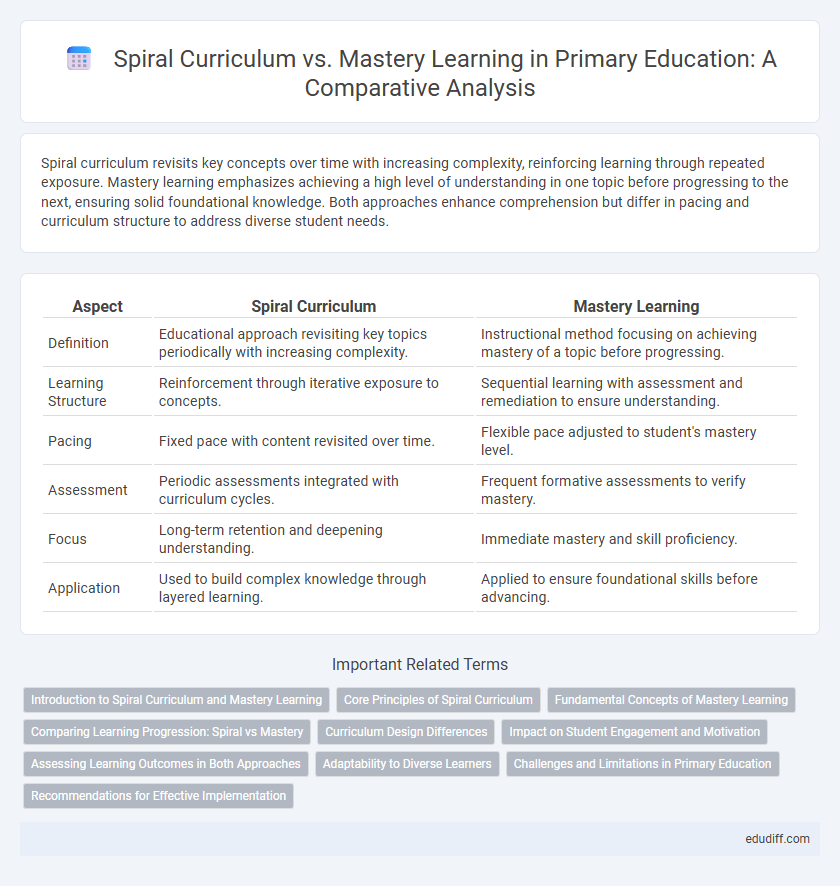Spiral curriculum revisits key concepts over time with increasing complexity, reinforcing learning through repeated exposure. Mastery learning emphasizes achieving a high level of understanding in one topic before progressing to the next, ensuring solid foundational knowledge. Both approaches enhance comprehension but differ in pacing and curriculum structure to address diverse student needs.
Table of Comparison
| Aspect | Spiral Curriculum | Mastery Learning |
|---|---|---|
| Definition | Educational approach revisiting key topics periodically with increasing complexity. | Instructional method focusing on achieving mastery of a topic before progressing. |
| Learning Structure | Reinforcement through iterative exposure to concepts. | Sequential learning with assessment and remediation to ensure understanding. |
| Pacing | Fixed pace with content revisited over time. | Flexible pace adjusted to student's mastery level. |
| Assessment | Periodic assessments integrated with curriculum cycles. | Frequent formative assessments to verify mastery. |
| Focus | Long-term retention and deepening understanding. | Immediate mastery and skill proficiency. |
| Application | Used to build complex knowledge through layered learning. | Applied to ensure foundational skills before advancing. |
Introduction to Spiral Curriculum and Mastery Learning
Spiral Curriculum, developed by Jerome Bruner, revisits key concepts repeatedly over time at increasing levels of difficulty, reinforcing learning and deepening understanding. Mastery Learning, introduced by Benjamin Bloom, emphasizes achieving a high level of comprehension in one topic before progressing to the next, ensuring students master foundational skills. Both educational approaches aim to improve retention and comprehension but differ in sequencing and pacing strategies.
Core Principles of Spiral Curriculum
The Spiral Curriculum emphasizes revisiting key topics repeatedly with increasing complexity to reinforce learning and deepen understanding over time. This approach organizes content in a cyclic manner, allowing learners to build on prior knowledge and connect new information meaningfully. Core principles include the gradual progression through related concepts and continuous reinforcement to enhance long-term retention and mastery.
Fundamental Concepts of Mastery Learning
Mastery Learning emphasizes achieving a thorough understanding of fundamental concepts before advancing, ensuring learners reach a high level of proficiency in each topic. This approach relies on continuous assessment and personalized feedback to address individual learning gaps, promoting long-term retention and skill acquisition. Mastery Learning's focus on deep comprehension contrasts with the Spiral Curriculum, which revisits topics periodically with increasing complexity.
Comparing Learning Progression: Spiral vs Mastery
Spiral curriculum revisits key concepts repeatedly with increasing complexity, allowing learners to build understanding gradually over time. Mastery learning requires students to achieve a thorough understanding of one topic before moving on to the next, ensuring proficiency at each stage. While spiral curriculum supports long-term retention through cyclical exposure, mastery learning emphasizes depth and immediate competency in a linear progression.
Curriculum Design Differences
Spiral curriculum revisits key concepts repeatedly with increasing complexity to enhance long-term retention and deepen understanding, while mastery learning emphasizes achieving proficiency in one topic before moving to the next. In curriculum design, spiral models incorporate cyclic exposure and cumulative skills development, contrasting with mastery learning's linear progression and frequent assessments to ensure competency. The spiral approach supports gradual knowledge integration, whereas mastery learning prioritizes thorough mastery of discrete units for personalized pacing.
Impact on Student Engagement and Motivation
Spiral Curriculum continuously revisits key concepts, reinforcing learning and maintaining student interest through progressively complex material, which enhances engagement by providing a sense of achievement and curiosity. Mastery Learning ensures students achieve a deep understanding before moving on, boosting motivation through clear goals and immediate feedback that builds confidence and reduces frustration. Both approaches positively impact student engagement and motivation but differ in pacing and reinforcement strategies tailored to diverse learning needs.
Assessing Learning Outcomes in Both Approaches
Spiral Curriculum assesses learning outcomes by revisiting key concepts at increasing levels of complexity, enabling continuous reinforcement and deeper understanding over time. Mastery Learning evaluates outcomes through formative assessments that ensure students achieve a high level of proficiency before advancing to subsequent topics. Both approaches emphasize ongoing assessment, but Spiral Curriculum integrates cumulative review while Mastery Learning requires demonstrated mastery for progress.
Adaptability to Diverse Learners
Spiral Curriculum enhances adaptability to diverse learners by revisiting key concepts at increasing levels of complexity, allowing students to build understanding gradually and accommodate varying learning paces. Mastery Learning ensures all students achieve a high level of proficiency before progressing, adapting instruction to individual needs through targeted feedback and corrective measures. Both methods support differentiated instruction, but Spiral Curriculum emphasizes continual reinforcement, while Mastery Learning focuses on personalized mastery benchmarks.
Challenges and Limitations in Primary Education
Spiral curriculum in primary education often faces challenges such as repeated content causing student disengagement and difficulties in ensuring retention over time. Mastery learning requires significant individualized pacing, which can be resource-intensive and challenging to implement consistently in diverse classrooms. Both approaches can struggle with balancing curriculum depth and breadth while meeting varying student needs and maintaining teacher workload sustainability.
Recommendations for Effective Implementation
Implementing a spiral curriculum effectively requires recurring exposure to core concepts with increasing complexity to reinforce long-term retention and skill development. Mastery learning benefits from clearly defined learning objectives, regular formative assessments, and timely, targeted feedback to ensure students achieve thorough understanding before progressing. Combining these approaches by integrating spaced repetition with mastery checkpoints creates a robust framework for sustained academic success.
Spiral Curriculum vs Mastery Learning Infographic

 edudiff.com
edudiff.com